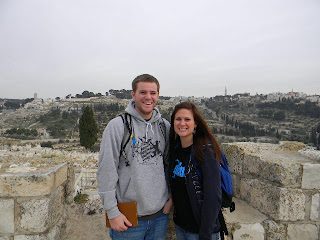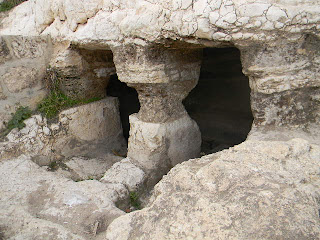Jerusalem!!!!!
For one of the classes at Ibex we have to write a field report after we have a field trip day. I just finished my first field report and thought i would post it as my blog because it describes the day throughly. There is a lot of info with it but i put pictures in the help make it more exciting:)
Today we went to the Old City in Jerusalem. This was an amazing day. I saw things I never thought I would see, things I wanted to see, and things I didn’t even know existed. There is so much history and age in the Old City that I did not quite expect to see. I knew that there would be many biblical sites but I did not fully thinking about the age that they date back to. The fact that some of these sites were over 2000 years old amazed me.
We started the day on top of a hostel just inside Joppa (Joffa) Gate. This was a good way to start this trip because it gave us a layout of the land of Jerusalem from up above and allowed us to become familiar with it. From there we saw for the first time the Dome of the Rock, The Holy Scepter, The Hebrew University, Agustin Victorian Hospital, and the Russia Church of Ascension. Out of all of these places the one that stood out to me the most was the Dome of the Rock, because it was the most recognizable to me. I had seen it on the news and different places so I recognized it right when I saw it. From the top of the hostel we could see almost all of the Old City. We could see into the four different quarters, which are the Muslim, Christian, Jewish, and Armenian quarters. The Old City was much smaller than I thought because we could also see the walls on the eastern side as we stood on the western side.
From there we stopped by Shabon the money changer and got shekels. Then we went to the pools of Bethesda. This site was mentioned in John 5 as the place in which Jesus heals the man on the Sabbath. He tells the man to stand up and take his mat and leave but because it was the Sabbath it was against the law to pick up his mat. He does it anyway and the Jewish leaders address him and then they address Jesus asking him if it is lawful to heal on the Sabbath. Jesus gives them an outstanding answer with which they don’t know what to say. The beginning of this story, the part with Jesus healing the man and the man standing up and walking, takes place at the pools of Bethesda and that is where we were. That really had an impact on me. I stood not only in the same biblical site that Jesus did, but it was also a site of one of his miracles. These pools were very deep and amazing to look at because they displayed the engineering of the day. The other significant thing about this site was that before Jesus healed the man there the people believed that this was a place of healing and that the water healed people. This was a Hellenistic superstition that the people believed. So when Jesus healed this man there it was as if he was saying that he had the power over that superstition and that he could heal by his power alone.
Next we went to the Struthion pool. It was at this site that tradition says Jesus went through the arches and was handed over to the crowds that brought his crucifixion. These arches would have been covering the pools but we know from the accounts of Josephus that the pool were in fact not covered, which means that what tradition says was wrong. The arches here were not around during the time of Jesus but the pools were. This was probably not the place in which Jesus was handed over to the crowd.
After that we grabbed some lunch and then went through Damascus gate to the top of the wall. The first stop along the top of the wall was a view of Gordon’s Calvary. This is a hillside outside the walls of The Old City which is a candidate for the site of the crucifixion and burial of Jesus. Charles Gordon saw a skull in the hillside, with a creative imagination, and believed it to be the place of the skull were Jesus was offered Wine mixed with gall. This cannot be true because there are tombs there that date back to the O.T. times and Jesus was buried in 33 A.D. which is not O.T.
Then we continued on top of the wall to the eastern side with a front row seat to the Mount of Olives. There we read about Christ’s return in Zechariah 14. It says that Christ will come and stand on the Mount of Olives and the mountain will split in two and a valley will open up. That was amazing to look at the mountain as that passage was being read. It also talks about how Jerusalem will change and with a turn of the head we could look into Jerusalem as that part of the passage was read. That was a candidate for my favorite part of the day.
Then we walked up into the Jewish quarter out of the Muslim quarter. That was change in scenery. The Muslim and Jewish quarters are easy to tell apart because they are completely different. In the Muslim quarter people are selling everything you can think of and in the Jewish quarter the first thing we saw was history. We saw Hezekiah’s road. He built this road to connect more of the city together. It was discovered in 1967.
After that we went to the Western Wall. The Western Wall was the climax of the Jewish quarter. After getting stopped at the security for the pocket knife I had in my backpack, we went down to the wall. We saw the men and women standing up against the wall putting their prayers into the wall. They were in full Jewish attire and were fervently praying. The guys went inside the wall, which required something wore on our head. Jewish men were praying and reading all within and around the wall. I got to place my hand on a stone that was put in place during the reign of Herod the Great, which was around 36B.C. - 4 A.D. This wall is considered the holiest place in Judaism because it is the closest to the Holy of Holy’s they can get. Interestingly the Holiest Muslim place stands right behind the Western wall.
We then made our way outside the city walls and went to what are called Mikvas. They were pools of water that people would walk into impure and then walk out pure. It was a ritual cleansing and probably where baptism came from. These specific Mikvas most likely date back to the time of Christ.
Our last stop of the day was the Zion gate. This gate is different from the other gates in that this was the gate that the Jewish took back to Old City through in the 6 Day war. Around the gate we saw the bullet holes from when this took place in 1967. When they did this they took the Western Wall, and the Jewish quarter.
The trip into the Old City is one I will never forget and one that I will replay in my mind often. I look forward to many more trips into the Old City and seeing more of these sites and others.
We also had our first schwarma. It was a favorful experience.
Thanks for reading!
Ben and Christina














My favorite part was when you said: We not only stood at the same place Jesus stood, but also where Jesus performed a miracle. That's unimaginable!!
ReplyDelete